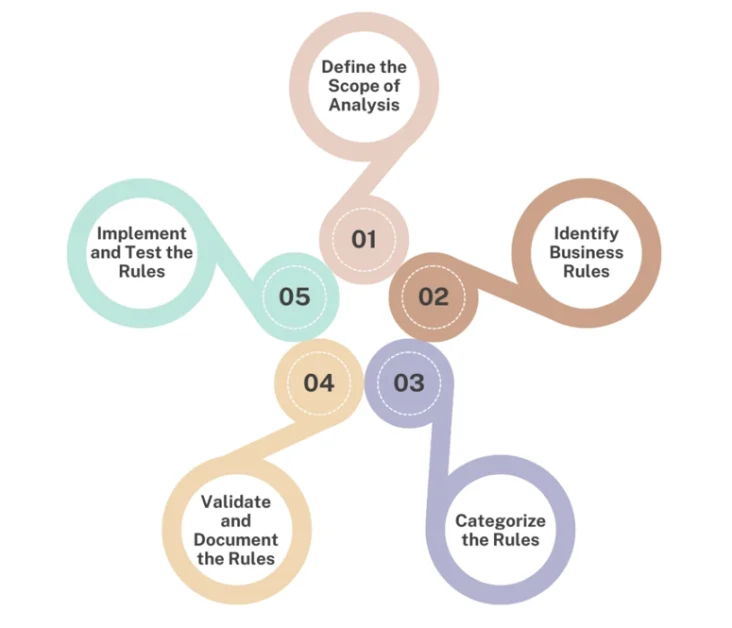Last Updated on November 15, 2024 by Techcanvass Academy
In today’s dynamic business environment, IT and business teams constantly face translating complex organizational policies into seamless digital processes. One crucial technique that bridges this gap is Business Rule Analysis. Did you know that 78% of companies face issues maintaining consistency across their business operations due to poorly defined business rules? As companies strive for automation, compliance, and data-driven decision-making, understanding and conducting effective Business rule analysis becomes a key differentiator.
In this article, we’ll explore Business Rules Analysis, why it matters, and how you can conduct it effectively with real-world examples, use cases, and actionable insights.
What is Business Rules Analysis?
Business Rules Analysis is the process of identifying, defining, and documenting the rules that govern the operations, behaviors, and decisions within an organization. These rules reflect the company’s policies, constraints, guidelines, and business logic, forming the backbone of decision-making processes. Business rules can be applied across various aspects, such as:
- Data Validation: Ensuring data integrity by defining rules
- (e.g., “Customer age must be over 18”).
- Process Control: Governing business processes
- (e.g., “An order cannot be processed if the payment status is pending”).
- Decision-Making: Establishing criteria for business decisions
- (e.g., “Discounts apply only to orders above $100”).
Why is Business Rules Analysis important?
Conducting a business rules analysis is critical for several reasons:
- Consistency: Defined rules help maintain consistent decision-making and process execution across departments.
- Compliance: Ensures adherence to industry regulations, legal requirements, and internal policies.
- Efficiency: Reduces manual interventions by automating decision logic.
- Scalability: Simplifies process updates and modifications as business requirements evolve.
A report by IIBA highlights that effective Business Rules Analysis can lead to a 25-30% reduction in process errors, increasing overall operational efficiency.
Useful Links – CBAP Certification Training | Business Analyst Requirements: Key Skills and Qualifications
How To Conduct Business Rules Analysis

Step 1: Define the scope of the analysis
Before diving into rule identification, it’s essential to understand the project’s context and goals. Determine:
- What processes are involved?
- What decisions need to be made?
- Which stakeholders should be consulted?
For instance, if a retail company wants to automate its discount policy, the analysis should cover aspects like eligible products, customer segments, and discount criteria.
Step 2: Identify Business Rules
Gather and document the rules that influence business processes. This can be done through:
- Interviews and Workshops: Engage stakeholders, such as business users, subject matter experts, and compliance officers, to gather rules.
- Document Analysis: Review existing policy documents, SOPs, and compliance guidelines.
Example: A bank’s loan approval process may include rules like:
- Loan applications with a credit score below 600 must be rejected automatically.
- A loan can only be approved if the applicant’s income exceeds $50,000 annually.
Step 3: Categorize the Rules
Classify the identified rules to ensure clarity and better organization. Common categories include:
- Structural Rules: Define the structure or relationship between data
- (e.g., An invoice must have at least one item).
- Operational Rules: Dictate business operations
- (e.g., All international orders must include a shipping charge).
- Decision-Making Rules: Guide decision logic
- (e.g., Approve refund requests if the return is within 30 days).
Step 4: Validate and Document the Rules
Validation is crucial to ensure that the rules align with business objectives and stakeholder expectations. Techniques like walkthroughs and peer reviews can help. Use a consistent format for documentation, including:
- Rule ID: Unique identifier for tracking.
- Description: Clear explanation of the rule.
- Conditions: The criteria or conditions under which the rule applies.
- Action: The decision or action triggered by the rule.
Useful Links – CBAP Certification Training | Business Analyst Requirements: Key Skills and Qualifications
Step 5: Implement and Test the Rules
After documenting the rules, integrate them into the relevant business processes or systems. This could involve configuring software applications, updating business process models, or embedding the rules into decision-making tools.
Testing the rules is vital to ensure they work as expected. Use test scenarios and simulation tools to verify the accuracy and effectiveness of each rule.
Case study: A global e-commerce company implemented business rules for automated fraud detection, such as:
- Flag orders with shipping addresses different from billing addresses for manual review. This helped reduce fraudulent transactions by 40%, improving customer trust and satisfaction.
Top 3 Actionable Takeaways
- Involve Stakeholders early: Engage business users, IT teams, and subject matter experts during the analysis phase to gather comprehensive and accurate business rules.
- Use a Standardized format: Document rules in a consistent and structured manner to make them easily understandable and maintainable.
- Continuously Review and update rules: Business rules are dynamic and need regular updates to reflect changes in policies, regulations, or business objectives.
Immediate steps to take
- Audit your existing rules: Start by reviewing your current documented rules. Are they up to date? Are they being followed?
- Set up a Business Rules repository: Create a centralized place for storing and managing all business rules for easy access and updates.
- Leverage Tools and Software: Use Business Rules Management Systems (BRMS) like IBM ODM or Drools to automate rule implementation.
Recommended resources
- IIBA: An in-depth resource for understanding Business Rules Analysis techniques.
- CBAP Certification Course: Enhance your skills with specialized courses tailored for Business Analysts.
Conclusion
Business Rules Analysis is a critical component of effective business process management and decision-making. By following a structured approach, involving the right stakeholders, and leveraging modern tools, businesses can streamline their operations, reduce errors, and adapt quickly to changing market conditions. Whether you’re a business analyst, project manager, or IT professional, mastering Business Rules Analysis can significantly boost your project success rates and contribute to overall business growth.


